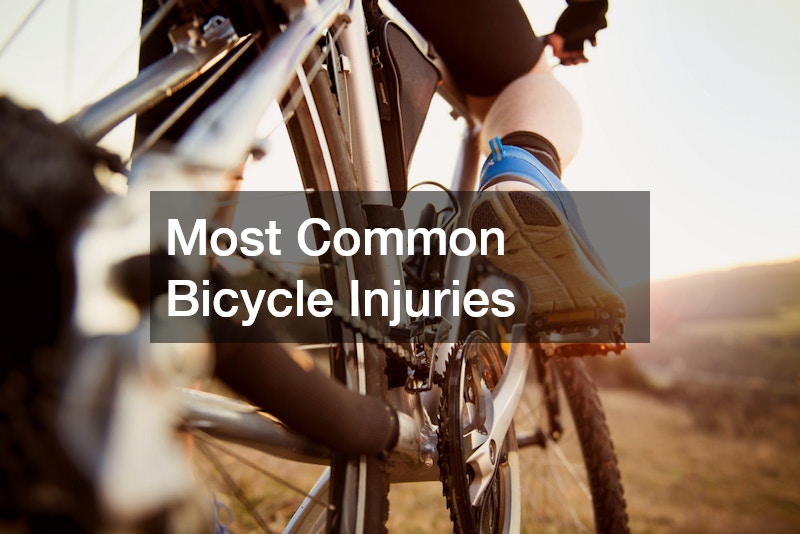
When it comes to biking, safety should always be a priority. Despite the benefits of cycling, it’s essential to be aware of common injuries and know how to prevent them. This article delves into the most frequent bicycle injuries the may require a bicycle accident attorney and offers guidance on prevention and treatment.
What are the most common injuries sustained from biking?
Fractures and Broken Bones
Fractures can occur from falls or collisions. Common sites include wrists, arms, and collarbones, which are frequent due to the natural instinct to brace oneself during a fall.
The sudden impact of a crash can lead to stress fractures over time if not addressed promptly. Protective gear plays a significant role in minimizing these injuries.
Cyclists often overlook the need for medical evaluation after seeming minor mishaps. Ignoring small fractures can lead to long-term complications.
Prevention and Recovery for Fractures
Wear protective gear like gloves and pads to safeguard against fractures and other injuries. The immediate consultation of a doctor is crucial for a proper diagnosis and treatment plan.
Physical therapy is an important part of recovery, enhancing mobility and strength post-injury. Engaging in regular muscle strengthening exercises can prevent future incidents.
Monitoring recovery progress ensures optimal healing without delays. Protecting your body with appropriate gear and getting help as needed are key preventative tactics.
Road Rash
Road rash is a superficial injury, often caused by sliding on the pavement. This type of abrasion can be both painful and prone to infection if not treated properly.
It commonly affects lower limbs, especially when skidding occurs. Wearing long sleeves and pants can reduce the severity of these injuries.
In some cases, extensive road rash may require professional medical care. Managing such injuries effectively can significantly influence recovery time.
Treating and Preventing Road Rash
Always wear protective clothing to minimize the risk of road rash. Long, breathable garments act as an additional barrier against harsh surfaces.
Cleaning and dressing wounds properly are imperative to prevent infection and promote healing. Overlooking minor abrasions can lead to more serious issues, necessitating comprehensive care.
Regularly inspect gear to ensure it remains in good condition. Maintaining an emphasis on gear quality can help diminish injury severity.
How do head injuries occur, and how serious can they be?
Concussions
A concussion is a brain injury that can happen after an impact to the head. Symptoms include confusion or difficulty in concentrating, which can affect daily activities.
Immediate action, including ceasing activity, is critical to prevent complications. Continued monitoring is necessary to avoid more severe symptoms later.
Consult a healthcare professional if any concussion symptoms arise. Timely intervention can prevent long-term consequences.
Helmet Safety and Concussion Prevention
Always wear a properly fitted helmet to reduce the risk of concussion. Helmets should meet certified safety standards for maximum protection.
Regularly inspect helmets for damage to ensure effectiveness. Persistent vigilance on helmet condition and fit enhances protection.
Participating in educational programs about helmet safety can reinforce proper usage habits. Knowledge is a major component of injury prevention.
Skull Fractures
These are less common but can occur in severe accidents. Though rare, skull fractures indicate a significant impact at high velocities or angles.
Severe head impacts may also lead to additional injuries, compounding the risk involved. You must seek immediate medical attention to limit further damage.
Consistent helmet use is fundamental in preventing these situations. Helmet safety remains a primary line of defense against serious accidents.
Identifying and Treating Skull Fractures
Seek immediate medical attention if you suspect a skull fracture. Professional intervention is necessary to ascertain internal injury severity and correct treatment.
In children, head-specific injuries require vigilant observation, as symptoms might differ. Early realization and intervention improve recovery outcomes.
Wear helmets and cycle cautiously, keeping speed and environmental conditions in mind. Proactive safety measures reduce the likelihood of grave incidents.
What are the typical injuries resulting from collisions with cars?
Spinal Injuries
Spinal injuries can result from high-impact collisions, affecting mobility and quality of life. Such injuries can range from minor to major, with severe consequences.
Protecting the spinal column is critical to prevent paralysis and other mobility issues. A collision’s aftereffects can persist, requiring intervention.
Immediate medical evaluation after any collision is a prudent step. Preventing and mitigating risks through careful riding and gear usage is essential.
Precautionary Measures for Spinal Safety
Use reflective gear and lights to increase visibility, deterring possible fatal collisions. Visibility is pivotal in enhancing safety on the road.
Avoiding cycling on busy roads where possible reduces the risk of car-cyclist interactions. Route planning with safety in mind is key for accident prevention.
Regular safety evaluations of your equipment can uncover hidden issues. Staying aware of your surroundings while riding is especially important.
Soft Tissue Injuries
These include sprains and strains from sudden impacts, leading to discomfort and immobility. Sudden impacts are particularly troublesome without proper safety gear.
Prompt recovery is necessary to restore function and prevent further injury. Soft tissue injuries, if neglected, can nag at future performance.
Injury prevention includes maintaining a fitness regimen to strengthen muscles and joints. The role of a physical therapist can be crucial in overseeing recovery.
Treatment and Recovery of Soft Tissue Injuries
RICE (Rest, Ice, Compression, Elevation) is essential for recovery. Consistent application of these practices can substantially improve outcomes.
Consult a physical therapist if necessary, especially when regular activities are impeded. Therapeutic guidance ensures a smooth recuperation process.
Maintaining flexibility and strength through regular exercise is invaluable. Integrated care approaches optimize body resilience against potential injuries.
Understanding common bicycle injuries and taking steps to prevent them is crucial for any cyclist. By prioritizing safety with proper equipment, technique, and awareness, you can enjoy cycling while minimizing the risk of injury.

